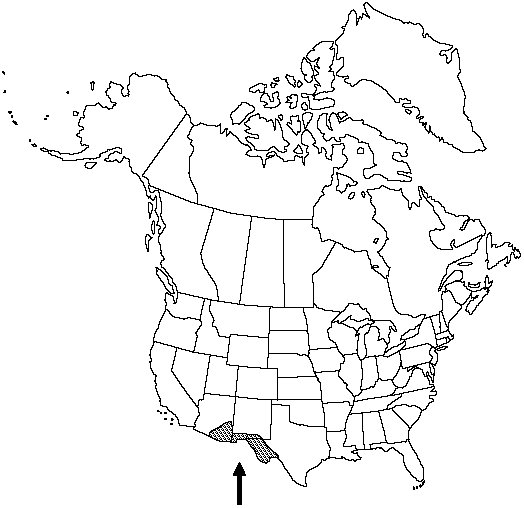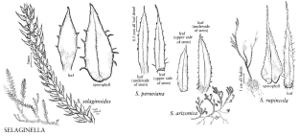Difference between revisions of "Selaginella rupincola"
Bull. Torrey Bot. Club 25: 129. 1898.
FNA>Volume Importer |
FNA>Volume Importer |
||
| Line 22: | Line 22: | ||
|elevation=1000–2000 m | |elevation=1000–2000 m | ||
|distribution=Ariz.;N.Mex.;Tex.;Mexico. | |distribution=Ariz.;N.Mex.;Tex.;Mexico. | ||
| − | |discussion=<p>Selaginella rupincola is allied to S. bigelovii. It is one of the presumed parents of S. × neomexicana (see discussion). In addition to characteristics given, it can be separated from S. bigelovii in having hairs often running along the ridges of the abaxial groove, whereas S. bigelovii has nonhairy ridges on the abaxial groove.</p> | + | |discussion=<p><i>Selaginella rupincola</i> is allied to <i>S. bigelovii</i>. It is one of the presumed parents of <i>S.</i> × <i>neomexicana</i> (see discussion). In addition to characteristics given, it can be separated from <i>S. bigelovii</i> in having hairs often running along the ridges of the abaxial groove, whereas <i>S. bigelovii</i> has nonhairy ridges on the abaxial groove.</p> |
|tables= | |tables= | ||
|references= | |references= | ||
| Line 45: | Line 45: | ||
|publication year=1898 | |publication year=1898 | ||
|special status= | |special status= | ||
| − | |source xml=https://jpend@bitbucket.org/aafc-mbb/fna-data-curation.git/src/ | + | |source xml=https://jpend@bitbucket.org/aafc-mbb/fna-data-curation.git/src/8f726806613d60c220dc4493de13607dd3150896/coarse_grained_fna_xml/V2/V2_589.xml |
|genus=Selaginella | |genus=Selaginella | ||
|subgenus=Selaginella subg. Tetragonostachys | |subgenus=Selaginella subg. Tetragonostachys | ||
Revision as of 15:49, 18 September 2019
Plants on rock or terrestrial, forming loose clumps. Stems radially symmetric, underground (rhizomatous) and aerial, not readily fragmenting, irregularly forked; both rhizomatous and aerial stems often with 1 branch arrested, budlike, tips straight; rhizomatous stems hard to distinguish on wholly creeping plants; aerial stems erect or ascending, sometimes decumbent to slightly creeping, budlike arrested branches restricted mostly near stem base. Rhizophores borne on upperside of stems, restricted to lower stems or throughout stem length, 0.3–0.5 mm diam. Leaves dimorphic, not clearly ranked. Rhizomatous stem leaves persistent or deciduous, tightly appressed, scalelike. Aerial stem leaves appressed, ascending, green, linear-lanceolate, 3–4.7 × 0.45–0.65 mm; abaxial ridges present; base abruptly adnate, rounded, pubescent; margins long-ciliate, cilia white to whitish, spreading, 0.1–0.2 mm; apex not keeled to slightly keeled; bristle white to whitish or yellowish to greenish near base, puberulent, 0.65–1.85 mm (1/3–1/2 length of leaves). Strobili solitary, 0.5–2.5(–3.5) cm; sporophylls lanceolate, strongly tapering toward tip, abaxial ridges prominent, base glabrous, margins short-ciliate, apex long-bristled.
Habitat: Exposed ledges and rock, steep slopes, rock crevices or gravelly soil
Elevation: 1000–2000 m
Distribution

Ariz., N.Mex., Tex., Mexico.
Discussion
Selaginella rupincola is allied to S. bigelovii. It is one of the presumed parents of S. × neomexicana (see discussion). In addition to characteristics given, it can be separated from S. bigelovii in having hairs often running along the ridges of the abaxial groove, whereas S. bigelovii has nonhairy ridges on the abaxial groove.
Selected References
None.
